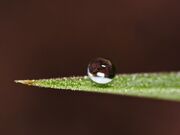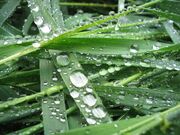Assessment |
Biopsychology |
Comparative |
Cognitive |
Developmental |
Language |
Individual differences |
Personality |
Philosophy |
Social |
Methods |
Statistics |
Clinical |
Educational |
Industrial |
Professional items |
World psychology |
Biological: Behavioural genetics · Evolutionary psychology · Neuroanatomy · Neurochemistry · Neuroendocrinology · Neuroscience · Psychoneuroimmunology · Physiological Psychology · Psychopharmacology (Index, Outline)

Dew drop on a hydrophobic leaf surface

Water drops on the hydrophobic surface of grass
- For other uses, see Hydrophobia
Hydrophobe (from the Greek (hydros) "water" and (phobos) "fear") in chemistry refers to the physical property of a molecule that is repelled from a mass of water.
Hydrophobic molecules tend to be nonpolar and thus prefer other neutral molecules and nonpolar solvents. Hydrophobic molecules in water often cluster together. Water on hydrophobic surfaces will exhibit a high contact angle.
Examples of hydrophobic molecules include the alkanes, oils, fats, and greasy substances in general. Hydrophobic materials are used for oil removal from water, the management of oil spills, and chemical separation processes to remove non-polar from polar compounds.
Hydrophobic is often used interchangeably with "lipophilic". However, the two terms are not synonymous. While hydrophobic substances are usually lipophilic, there are exceptions — the silicones, for instance.
Chemical background
According to thermodynamics, matter seeks to be in a low-energy state, and bonding reduces chemical energy. Water is electrically polarized, and is able to form hydrogen bonds internally, which gives it many of its unique physical properties. But, since hydrophobes are not electrically polarized, and because they are unable to form hydrogen bonds, water repels hydrophobes, in favour of bonding with itself. It is this effect that causes the hydrophobic interaction — which in itself is incorrectly named as the energetic force comes from the hydrophilic molecules.[1] Thus the two immiscible phases (hydrophilic vs. hydrophobic) will change so that their corresponding interfacial area will be minimal. This effect can be visualized in the phenomenon called phase separation.
Superhydrophobic
Superhydrophobic materials have surfaces that are extremely difficult to wet with water contact angles in excess of 150°. Many of these very hydrophobic materials found in nature rely on Cassie's law and are biphasic on the submicrometer level with one component air. The Lotus effect is based on this principle. An example of a biomimetic superhydrophobic material in nanotechnology is nanopin film.
See also
- Hydrophile
- Amphiphiles
- Wetting
References
- Aryeh Ben-Na'im Hydrophobic Interaction Plenum Press, New York (ISBN 0-306-40222-X)
External links
| This page uses Creative Commons Licensed content from Wikipedia (view authors). |